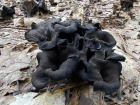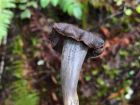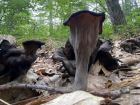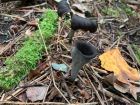Fruiting Body lacks a clearly defined cap and stem, is tubular at first and becomes deeply vase-shaped as it matures. The upper edge is rolled under when young and often remains partly rolled under when mature. The upper or inner surface is black to dark grey, finely roughened or covered with fine scales and dark fibres that sit over a paler greyish or greyish brown background. The lower and outer fertile surface is a much lighter shade of gray. The fertile surface is more or less smooth but may have decurrent wrinkles. Flesh thin, brittle and blackish. Spore print white to very pale yellow.
Microscopic Features: The spores are broadly ellipsoidal and smooth, measuring 11.5–16 x 7–10 μm and hyaline in appearance.
Craterellus cornucopioides on the First Nature Web site.
Craterellus cornucopioides on the MushroomExpert.Com Web site.
Many mushrooms are poisonous, and some can be lethally toxic. Distinguishing between edible and poisonous mushrooms can be very challenging. Therefore, we strongly advise against consuming wild mushrooms. This website does not contain any information about the edibility or toxicity of mushrooms.
Although efforts have been made to ensure accuracy on this website, the information may contain errors and omissions. Therefore, all content provided is for educational and informational purposes only and should not be relied upon or used as a basis for consuming any plants or mushrooms.
External links are provided for reference only. We do not endorse or take responsibility for the content, advice, or products found on these sites or in any advertisements shown on this website.




